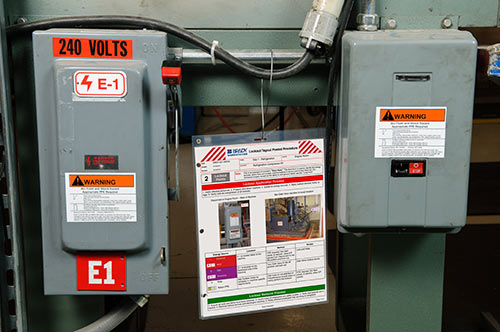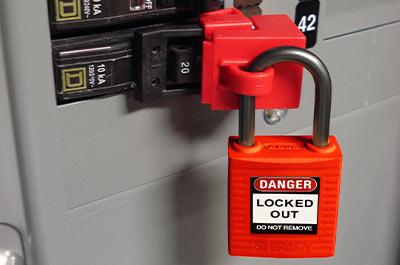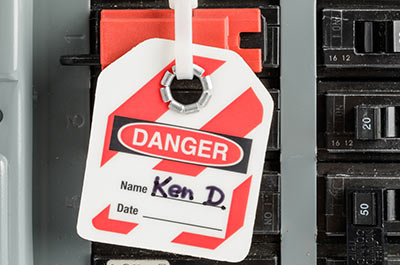Labels for Safety, Visuals and Facility ID Desktop Printers
Labels for Product, Wire and Lab ID Benchtop Printers
Labels for Safety, Visuals and Facility ID Desktop Printers
Labels for Product, Wire and Lab ID Benchtop Printers
Safety and Facility ID Desktop Printers
Product, Wire and Lab ID Benchtop Printers
Barcode Scanner and Printer Kits
Barcode Scanner and Printer Kits
PaintStripe Floor Marking Stencils
Valve Lockouts & Hose Lockouts
Group Lock Boxes & Permit Control
Brady Safety Lockout Tagout Services
Pipe Marker Accessories & Mounting Brackets
Maintenance and Production Tags
Calculators and Assessment Tools
Product Finders and Data Sheets
Controlling hazardous energy in 8 steps
Manufacturing facilities are usually abuzz with machines running and operators ensuring production goals are met. But, occasionally, equipment needs to undergo maintenance or be serviced. And when that happens, a safety procedure called lockout tagout (LOTO) is set into motion to prevent an unexpected startup or release of stored energy. Equipment is shut down, locked out and tagged, and is basically non-operational. Or is it?
Accidents resulting from improper LOTO procedures do, unfortunately, occur. In fact, they are often in OSHA’s annual list of the Top 10 Most Frequently Cited Standards.[1] Failure to contain hazardous energy can cause serious injuries to workers (or even death) caused by burns, crushing, lacerating, amputating or fracturing body parts.[2] And, workplaces can incur fines, too, if it’s determined OSHA’s standard for lockout tagout wasn’t followed.
This standard, The Control of Hazardous Energy (Lockout/Tagout) (29 CFR 1910.147), outlines measures for controlling different types of hazardous energy.[3] This is incredibly important to workplaces and workers alike, as compliant lockout tagout programs can prevent workplace injuries and even death.
If you’re updating or adding new machines and equipment to the workplace, it’s natural to think ahead about how you’ll train your personnel. But before this happens, you’ll need to write energy-control procedures for the equipment that outline the scope, authorization, rules and techniques employees will use.[4] Specifically, you’ll need to include:
In order to stay compliant, employees who work with machines and equipment must be trained so that they know their LOTO duties and understand the OSHA standard.

Because machines and equipment contain hazardous energy, it’s important to adhere to site-specific lockout tagout procedures. The steps below are outlined in OSHA’s 1910.147 App A - Typical minimal lockout procedure. [5]

Once it’s been determined a shutdown of equipment or machines must occur, authorized personnel need to notify all employees who will be affected by the shutdown. This can happen over radio, during a briefing in a room or in the physical location where the equipment is located. Employees need to be informed that equipment will be shut down and locked out before maintenance will occur. This required step initiates the LOTO procedure process.

If a machine needs maintenance or servicing, company LOTO procedures apply. As these procedures already exist, it’s easy to reference them. Specifically, these procedures show:

This step requires operating machines or equipment to be shut down. This can be accomplished through normal stopping procedures like pushing a STOP button, flipping a switch to an OFF position or closing a valve. Orderly shutdowns are necessary to avoid additional hazards caused due to stopping abruptly. These steps are listed in a particular order, so employees need to pay attention to the exact sequence.

This step requires isolating the machine or equipment from its source by using energy-isolating devices. It’s important to note these devices are not the normal operating controls. Energy-isolating devices should physically prevent the transmission of energy. Examples include a circuit breaker, a line valve or a block. ON/OFF and STOP buttons do not qualify as energy-isolating devices.

This step prevents manipulation of equipment or accidental startup. It’s accomplished in two steps: Lockout and Tagout.
A lockout tagout device (e.g., breaker or ball valve lockout) holds the energy isolating device in a SAFE / OFF position. Safety padlocks (key or combination) then prevent the removal of the energy-isolating device to ensure energy cannot flow from its source to the machine. Assigned locks should be applied to each energy-isolation device.

Tagout refers to using a tagout device on an energy-isolating device. It should be securely fastened to the isolating device to indicate the energy-isolating device and equipment may not be operated until the tag is removed. Essentially, it warns others not to restore energy. The tag should include the name of the employee who applied it and why. That way, if anyone has questions as to why the equipment is locked out, they know who to ask.


Once energy-isolating devices are locked out, this step requires checking for stored energy. All residual energy must be depleted or drained from the equipment to ensure it’s in a controlled state. Examples include:
If residual energy remains in a system, it’s a safety risk. You’ll need to relieve pressure, bleed liquids, vent gasses and release tension in compressed springs until the energy is dissipated.

This step is very important. More than just a double-check, it can save lives.
To verify that the equipment is disconnected from the energy source, you’ll need to test it. First, check that no personnel can be exposed to the threat of an energy hazard. Then, verify isolation by trying to operate it. This can include pushing an ON button or any other operating control, and visually checking gauges. Then, return the control / button to the OFF position after verifying isolation.
By performing this step, you’re ensuring the machine or equipment is now locked out and ready for servicing or maintenance.
It’s important to recognize this as part of the broader LOTOTO (Lockout, Tagout, Tryout) framework, emphasizing the critical role of tryout in reinforcing safety measures and preventing accidental energization during lockout tagout procedures.

When the machine or equipment has been serviced or repaired, it’s time to get the work area and personnel ready for startup. Procedures must be followed in the correct order.
Over time, your lockout tagout procedures may change. When that happens, employees will need to be updated. Even minor changes need to be understood and heeded. And, beyond site-specific procedural changes, everyone will need to follow the latest updates to the OSHA standard. It’s best to review and revise procedures annually within your energy program. This will give you the opportunity to fine-tune descriptions and tweak procedures if there’s a better way in which they can be done.
Operating machines and equipment should go smoothly, as should preparing for servicing or maintenance. If you need support to build a stronger and safer energy program, here are a few ways Brady can help:
Customized to meet your requirements, keep your employees safe and ensure your compliance:
Brady LINK360® safety software provides easy document management and workflow automation that meets OSHA compliance requirements, while the Brady Workstation Lockout Writer Software App allows you to create compliant lockout/tagout labels, tags and procedures in no time.
Innovative devices that fit your work, including: lockout tagout kits, stations, SafeKey Padlocks, hasps, tags, group lockboxes and various lockouts for circuit breakers, panels, valves and electrical equipment.
References

Learn how to keep your lockout tagout procedures OSHA-compliant
Learn More
How to create a sustainable LOTO program that keeps your workers safe.
Learn More
Comply with OSHA group LOTO requirements with these 5 best practices.
Learn More